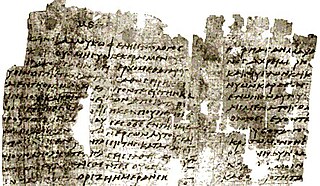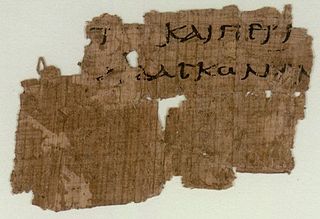
Papyrus 13, designated by siglum 𝔓13 or P13 in the Gregory-Aland numbering, is a fragmented manuscript of the New Testament in Greek. It was copied on papyrus in the 3rd century at approximately 225-250 CE.

Papyrus 87, designated by 𝔓87, is an early New Testament papyrus. It is the earliest known manuscript of the Epistle to Philemon. The surviving texts of Philemon are verses 13–15, 24–25.

Papyrus 92, designated by 𝔓92, is an early New Testament papyrus.

Papyrus 9, signed by 𝔓9, and named Oxyrhynchus papyri 402, is an early copy of the New Testament in Greek. It is a papyrus manuscript of the First Epistle of John, dating paleographically to the early 3rd century.
Papyrus 12, α 1033, designated by siglum 𝔓12, is an early copy of the New Testament in Greek. It is a papyrus manuscript of the Epistle to the Hebrews, it contains only Hebrews 1:1. The manuscript palaeographically has been assigned to ca. 285. It may have been a writing exercise or an amulet.

Papyrus 16, designated by 𝔓16, is an early copy of the New Testament in Greek. Originally, it may have been part of a papyrus manuscript of the Pauline Corpus of letters, but now only contains Philippians 3:10-17; 4:2-8. The manuscript has been paleographically assigned to the late 3rd century.

Papyrus 20, designated by 𝔓20, is an early copy of the New Testament in Greek. It is a papyrus manuscript of the Epistle of James, but it only contains Chapter 2:19-3:9. The manuscript has been paleographically assigned to the early 3rd century.

Papyrus 22, designated by 𝔓22, is an early copy of the New Testament in Greek. It is a papyrus manuscript of the Gospel of John, only containing extant John 15:25-16:2, 21–32. The manuscript has been paleographically assigned to the early 3rd century. It is the only identified New Testament papyrus to have been written originally as a roll; not a codex or re-using the back of a scroll.

Papyrus 23, designated by 𝔓23, is an early copy of the New Testament in Greek. It is a papyrus manuscript of the Epistle of James, it contains only James 1:10-12,15-18. The manuscript paleographically has been assigned to the early 3rd century.

Papyrus 29, designated by 𝔓29, is an early copy of the New Testament in Greek. It is a papyrus manuscript of the Acts of the Apostles which contains Acts 26:7-8 and 26:20. The manuscript paleographically has been assigned to the early 3rd century.

Papyrus 30, designated by 𝔓30, is an early copy of the New Testament in Greek. It is a papyrus manuscript of the Pauline epistles, it contains only 1 Thess 4:12-5:18. 25-28; 2 Thess 1:1-2; 2:1.9-11. The manuscript paleographically has been assigned to the 3rd century.

Papyrus 39, signed by 𝔓39, is an early copy of the New Testament in Greek. It is a papyrus manuscript of the Gospel of John, it contains only John 8:14-22. The manuscript paleographically had been assigned to the 3rd century. Written by professional scribe, in 25 lines per page, in large, beautiful letters. It has numbered pages.

Papyrus 48 (Gregory-Aland), signed by 𝔓48, is an early copy of a part of the New Testament in Greek. It is a papyrus manuscript of the Acts of the Apostles, it contains portions of Acts 23:11-29. The manuscript paleographically has been assigned to the 3rd century.

Papyrus 53, signed by 𝔓53, is an early copy of the New Testament in Greek. It is a papyrus manuscript containing parts of the Gospel of Matthew and the Acts of the Apostles: it contains only Matthew 26:29-40 and Acts 9:33-10:1. The manuscript palaeographically had been assigned to the 3rd century. These two fragments were found together, they were part of a codex containing the four Gospels and Acts or Matthew and Acts.

Papyrus 70, designated by 𝔓70, is an early copy of the New Testament in Greek. It is a papyrus manuscript of the Gospel of Matthew. The surviving texts of Matthew are verses 2:13-16; 2:22-3:1; 11:26-27; 12:4-5; 24:3-6.12-15. 𝔓70 has a fairly reliable text, though it was carelessly written. The manuscript palaeographically had been assigned to the late 3rd century.

Papyrus 77, designated by 𝔓77, is a papyrus manuscript of the Gospel of Matthew verses 23:30-39. It is written in Greek and has palaeographically been assigned a date anywhere from the middle 2nd century to the early 3rd century.

Papyrus 78, designated by 𝔓78, is an early copy of the New Testament in Greek. It is a papyrus manuscript of the Epistle of Jude. The surviving texts of Jude are verses 4-5 & 7-8. 𝔓78 is written in an elegant hand. The manuscript has been paleographically assigned to the 3rd century.

Papyrus 102, designated by 𝔓102, is an early copy of the New Testament in Greek. It is a papyrus manuscript of the Gospel of Matthew. The surviving texts of Matthew are verses 4:11-12; 4:22-23, they are in a fragmentary condition. The manuscript palaeographically has been assigned to the 3rd century.

Papyrus 113, designated by 𝔓113, is a fragment of an early copy of a section of the New Testament in Greek. It comes from a papyrus manuscript of the Epistle to the Romans. The surviving text features parts of Romans 2:12-13 on one side of the fragment and parts of 2:29 on the other.

Papyrus 114, designated by 𝔓114, is a copy of the New Testament in Greek. It is a papyrus manuscript of the Letter to the Hebrews, containing verses 1:7-12 in a fragmentary condition. The manuscript has been paleographically assigned by the INTF to the 3rd century CE. Papyrologist Philip Comfort dates the manuscript to Middle-Late 3rd century CE. The manuscript is now in the Papyrology Rooms of the Sackler Library at Oxford.



















